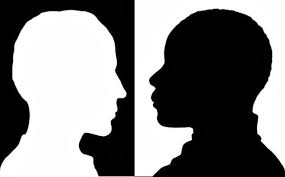|
Ronquillo, J., Denson, T. F., Lickel, B., Lu, Z.-L., Nandy, A., & Maddox, K. B. (2007). The effects of skin tone on race-related amygdala activity: an fMRI investigation. Social cognitive and affective neuroscience, 2(1), 39-44.
Todorov, A., & Engell, A. D. (2008). The role of the amygdala in implicit evaluation of emotionally neutral faces. Social cognitive and affective neuroscience, 3(4), 303-12.
Ito, T. a, & Urland, G. R. (2005). The influence of processing objectives on the perception of faces: an ERP study of race and gender perception. Cognitive, affective & behavioral neuroscience, 5(1), 21-36.
Kanwisher, N., McDermott, J., & Chun, M. M. (1997). The fusiform face area: a module in human extrastriate cortex specialized for face perception. The Journal of neuroscience : the official journal of the Society for Neuroscience, 17(11), 4302-11.
Racial Group Membership Is Associated to Gaze-Mediated Orienting in Italy
Pavan G, Dalmaso M, Galfano G, Castelli L (2011) PLoS ONE6(10): e25608. doi:10.1371/journal.pone.0025608 Adults Scan Own- and Other-Race Faces Differently
Fu G, Hu CS, Wang Q, Quinn PC, Lee K (2012) PLoS ONE 7(6): e37688.doi:10.1371/journal.pone.0037688 Democrats and Republicans Can Be Differentiated from Their Faces
Rule NO, Ambady N (2010) PLoS ONE 5(1): e8733.doi:10.1371/journal.pone.0008733 The MPI Facial Expression Database — A Validated Database of Emotional and Conversational Facial Expressions
Kaulard K, Cunningham DW, Bülthoff HH, Wallraven C (2012) PLoS ONE 7(3): e32321. doi:10.1371/journal.pone.0032321 
Brown eyed faces look more trustworthy than blue eyed faces
From saypeople.com - February 12, 2013 Researchers have found that the faces of the people with brown eyes look more trustworthy. This research has been published online in the journal PLoS Building biases in infancy: the influence of race on face and voice emotion matching.
Vogel M1, Monesson A, Scott LS. Dev Sci. 2012 May;15(3):359-72. doi: 10.1111/j.1467-7687.2012.01138.x. Epub 2012 Mar 1. Early in the first year of life infants exhibit equivalent performance distinguishing among people within their own race and within other races. However, with development and experience, their face recognition skills become tuned to groups of people they interact with the most. This developmental tuning is hypothesized to be the origin of adult face processing biases including the other-race bias. In adults the other-race bias has also been associated with impairments in facial emotion processing for other-race faces. The present investigation aimed to show perceptual narrowing for other-race faces during infancy and to determine whether the race of a face influences infants' ability to match emotional sounds with emotional facial expressions. Behavioral (visual-paired comparison; VPC) and electrophysiological (event-related potentials; ERPs) measures were recorded in 5-month-old and 9-month-old infants. Behaviorally, 5-month-olds distinguished faces within their own race and within another race, whereas 9-month-olds only distinguish faces within their own race. ERPs were recorded while an emotion sound (laughing or crying) was presented prior to viewing an image of a static African American or Caucasian face expressing either a happy or a sad emotion. Consistent with behavioral findings, ERPs revealed race-specific perceptual processing of faces and emotion/sound face congruency at 9 months but not 5 months of age. In addition, from 5 to 9 months, the neural networks activated for sound/face congruency were found to shift from an anterior ERP component (Nc) related to attention to posterior ERP components (N290, P400) related to perception. The N400 as an index of racial stereotype accessibility.
Soc Cogn Affect Neurosci. 2014 Apr;9(4):544-52. doi: 10.1093/scan/nst018. Epub 2013 Feb 5. Hehman E1, Volpert HI, Simons RF. The current research examined the viability of the N400, an event-related potential (ERP) related to the detection of semantic incongruity, as an index of both stereotype accessibility and interracial prejudice. Participants' EEG was recorded while they completed a sequential priming task, in which negative or positive, stereotypically black (African American) or white (Caucasian American) traits followed the presentation of either a black or white face acting as a prime. ERP examination focused on the N400, but additionally examined N100 and P200 reactivity. Replicating and extending previous N400 stereotype research, results indicated that the N400 can indeed function as an index of stereotype accessibility in an interracial domain, as greater N400 reactivity was elicited by trials in which the face prime was incongruent with the target trait than when primes and traits matched. Furthermore, N400 activity was moderated by participants' self-reported explicit bias. More explicitly biased participants demonstrated greater N400 reactivity to stereotypically white traits following black faces than black traits following black faces. P200 activity was additionally associated with participants' implicit biases, as more implicitly biased participants similarly demonstrated greater P200 reactivity to stereotypically white traits following black faces than black traits following black faces. |
| ||||||||||||||||||||||||||||||||||||||||||||||||||
- Home
- Overview
-
Understanding Hate
- Introduction
- What is Hate? >
-
The Roots of Hate
>
- Early Imprints >
- What Are We Doing To Our Children? >
- Effects of Trauma and Abuse >
- Causes and Effects of Bullying
- Trauma, bigotry, violence linked
- Authoritarian Upbringings >
- Absolutism and Insularity >
- Papers: Early Roots of Prejudice
- Impaired Cognition >
- The Violent Brain >
- Roots of Violence and Cruelty >
- Ghosts of the Past >
-
How Hate Manifests
>
- Hate in the News >
-
Group Influence
>
- Social Defenses >
- Fanning the Flames >
-
How We Fool Ourselves
>
-
Brain and Belief
>
- Search for Certainty >
- Index: All Biases, Distortions and Influences
-
Overcoming Hate
- Overview of Topics
- Introduction
-
Prevention
>
- Education >
-
Intervention
>
- Social Support and Inclusion >
- Helping Children in Dire Conditions >
- Preventing Violence and Bullying >
- Standing Up To Prejudice, Racism, and Bigotry >
- Training Our Protectors >
- Healing the Hurt >
- Educating Our Leaders >
- Resolving Conflict >
- Israel-Palestine >
- Promoting Dignity >
- Healing the Ghosts of the Past >
- Restorative Justice >
- Confronting Mass Atrocities >
- Social Advances >
- More Solutions >
-
Resources
- Tools

